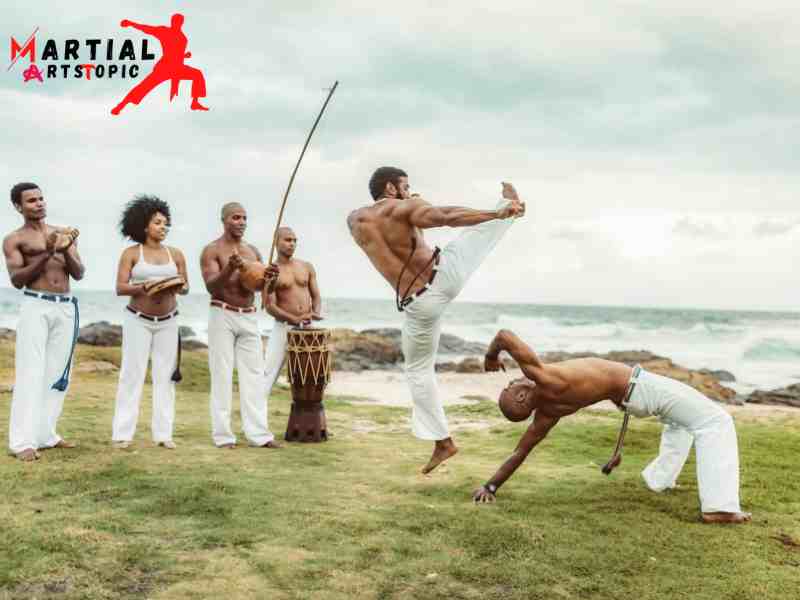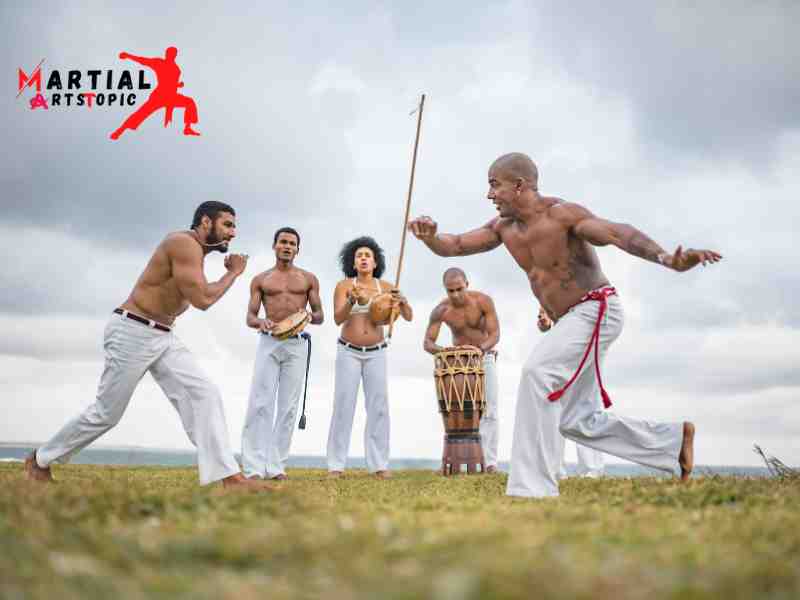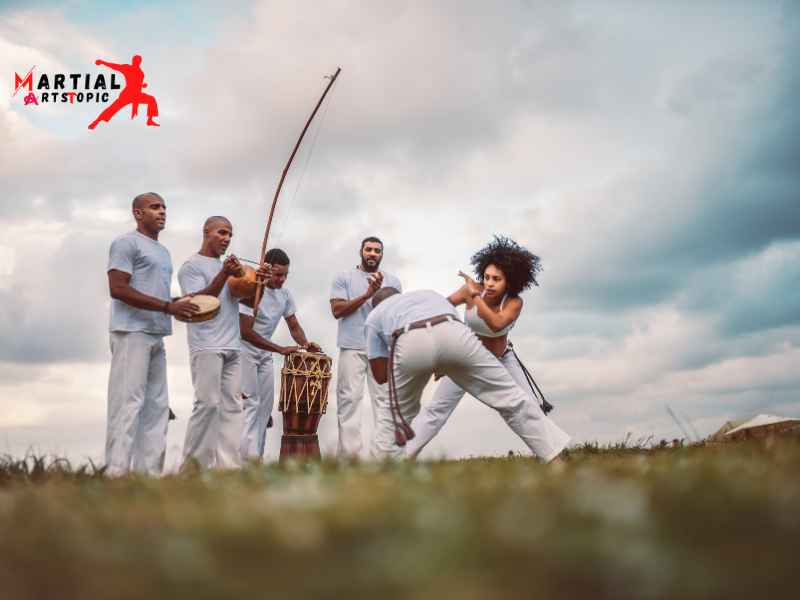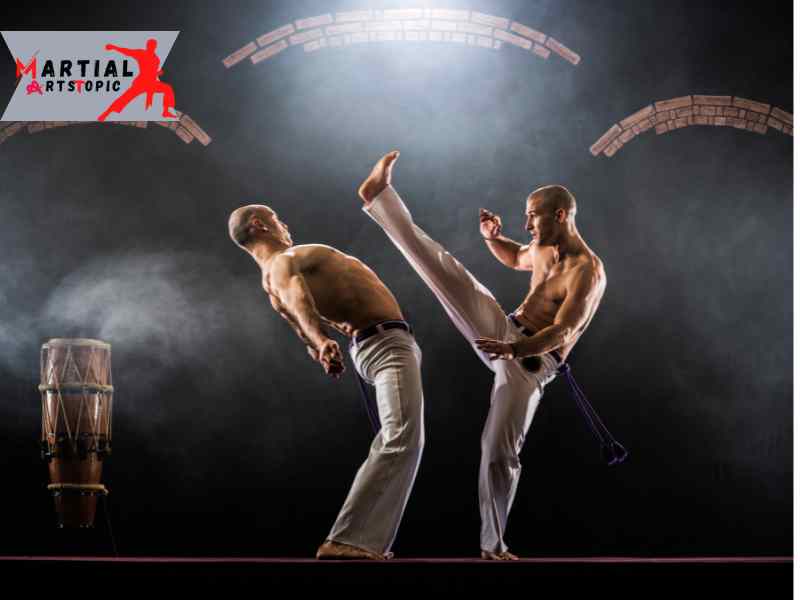
Unleashing the Power and Grace: The art of Capoeira Fighting
Capoeira fighting, a mesmerizing martial art form that combines elements of dance, acrobatics, and music, has captivated audiences around the world with its unique blend of power and grace. Originating in Brazil, this dynamic combat style has a rich history steeped in tradition and has developed into a breathtaking spectacle that showcases the agility, strength, and skill of its practitioners. In this blog post, we invite you to delve into the world of capoeira fighting and witness the fierce battles of its warriors.
The roots of capoeira can be traced back to the 16th century, during the era of slavery in Brazil. African slaves developed it as a means of self-defense and a way to preserve their cultural heritage. Disguised as a dance, capoeira allowed slaves to practice their fighting techniques discreetly, while also serving as resistance against their oppressors.
Fast forward to the present day, and capoeira has transformed into a dynamic martial art that combines fluid movements, acrobatics, and musical accompaniment. The artistry of capoeira lies not only in its physicality but also in the road, the circle in which the battles take place. The road is a sacred space where participants engage in a rhythmic exchange of kicks, sweeps, and takedowns, all while maintaining an intricate harmony with the accompanying music and singing.
At the heart of capoeira, fighting is the concept of jogo, which translates to “game” in Portuguese. Unlike traditional martial arts, capoeira emphasizes improvisation, creativity, and the ability to read and respond to one’s opponent’s movements. It is a game of strategy, where one must blend agility and strength with an acute awareness of timing and rhythm. The players, known as capoeira, engage in a constant dance-like flow, seamlessly transitioning between offensive and defensive maneuvers.
The spectacle of capoeira fighting is captivating, with its practitioners executing gravity-defying flips, spins, and kicks. The combination of high-flying acrobatics and lightning-fast strikes creates an exhilarating display of skill and athleticism. They execute each movement with precision, showcasing the years of training and dedication that go into mastering this art form.
But capoeira is not just about the physicality; it is also deeply rooted in the culture and history of Brazil. The music and singing that accompany the battles are an essential component of the capoeira experience. The bomb, a traditional musical instrument, sets the rhythm and dictates the pace of the game, while the songs tell stories of struggle, resilience, and freedom. The music adds an emotional layer to the battles, evoking a sense of connection and unity among the participants and spectators alike.
Witnessing a capoeira battle is a truly immersive experience, as the energy and passion of the fighters reverberates throughout the road. The intensity of the battles, combined with the vibrant music and the electric atmosphere, creates an unforgettable spectacle that leaves spectators in awe.
Whether you are a martial arts enthusiast or simply curious about different cultural traditions, capoeira fighting is a must-see. It showcases the power and grace of its warriors, who blend athleticism, creativity, and tradition into a mesmerizing display of human expression. So, immerse yourself in the world of capoeira, witness the fierce battles, and be captivated by the power and grace that unfolds before your eyes.
Definition and origin of Capoeira Fighting
Capoeira Fighting: Its Definition and Origin capoeira fighting is a mesmerizing martial art that combines elements of dance, acrobatics, and music. With its roots deeply embedded in the cultural history of Brazil, this unique form of self-expression has captivated people all around the world. In this blog post, we will delve into the definition and origin of capoeira fighting, shedding light on its rich heritage and the impact it has had on Brazilian culture.
What is Capoeira Fighting?
Capoeira fighting is a dynamic martial art characterized by fluid movements, quick kicks, and agile dodges. They often refer it to as a game, as we played it between two participants in a roda, a circular space where the capoeiristas showcase their skills. The players engage in a rhythmic exchange of attacks and defenses, accompanied by music and singing.
Origin of Capoeira Fighting

Capoeira fighting originated in Brazil during the colonial period, tracing its roots back to the 16th century. Enslaved Africans developed it brought to Brazil by the Portuguese. These African slaves found themselves in a harsh and oppressive environment, where they had to devise ways to defend themselves against their captors.
To disguise their martial art training, the slaves incorporated elements of dance and music into their fighting techniques. This fusion of different cultural influences gave birth to capoeira fighting, as we know it today. The slaves used capoeira not only as a means of self-defense but also to preserve their cultural heritage and maintain a sense of community among themselves.
The Evolution of Capoeira Fighting
Over the years, capoeira fighting has developed and branched into different styles, each with its own unique characteristics. The two major styles of capoeira are Angola and Regional.
I considered capoeira Angola the more traditional and ritualistic form of capoeira. It emphasizes a slower and more strategic approach, with an emphasis on maintaining a connection with the roots of the art. Low kicks, ground movements, and a focus on deception and improvisation characterize it.
Capoeira Regional is a more modern and athletic form that emerged in the 20th century. It places an emphasis on high kicks, acrobatics, and quick movements. Capoeira Regional is often practiced in a more competitive context and has gained popularity in the world of sports.
The Cultural Significance of Capoeira Fighting
In Brazil, capoeira fighting is not just a martial art; it is a cultural phenomenon deeply intertwined with the country’s history and identity. It has become a symbol of resistance, freedom, and unity.
In 1888, they abolished slavery in Brazil, and capoeira fighting, which was once illegal, gained recognition. It became a way for the marginalized communities, especially Afro-Brazilians, to assert their voice and celebrate their heritage.
Today, capoeira fighting has spread far beyond the borders of Brazil. It has gained popularity as exercise, self-defense, and artistic expression worldwide. Its fusion of athleticism, music, and dance continues to captivate people from all walks of life.
Brief explanation of capoeira fighting
Capoeira fighting, also known as the “dance of war,” is a Brazilian martial art that combines elements of acrobatics, dance, and music. Originating from the African slaves brought to Brazil, its fluid and rhythmic movements characterizes capoeira, incorporating kicks, sweeps, and ground techniques. What sets capoeira apart from other martial arts is its emphasis on creativity, improvisation, and the use of deceptive maneuvers. The participants engage in a game-like interaction called “roda,” where they showcase their agility, balance, and skill while responding to their opponent’s movements. Capoeira fighting is not only a physical discipline but also a rich cultural expression that promotes camaraderie, self-expression, and respect.
The Capoeira fighting: A Unique Brazilian Fighting Style
The Capoeira fighting: A Unique Brazilian Martial Art Capoeira fighting is a fascinating and unique Brazilian martial art that has captured the attention of people all around the world. With its combination of dance, acrobatics, and music, capoeira is not your typical fighting style. In this blog post, we will explore the origins, techniques, and cultural significance of capoeira fighting.
Originating in Brazil during the 16th century, African slaves developed capoeira as a means of self-defense. They disguised it as a dance to avoid detection by their captors. Over time, capoeira developed into a complex martial art that blends elements of dance, music, and acrobatics. Today, capoeira is not only self-defense, but also a cultural expression and a way of life for many practitioners.
One of the defining features of capoeira fighting is the roda, which means “circle” in Portuguese. The roda is a circular space where capoeira is performed, with participants forming a circle and taking turns playing various roles. The game, or jogo, is played between two capoeiristas who engage in a rhythmic exchange of movements, kicks, and sweeps. The goal is to outmaneuver and surprise your opponent, all while maintaining the fluidity and grace that capoeira is known for.
Its acrobatic movements and quick transitions characterize capoeira fighting between attacks and defenses. Capoeiristas often incorporate flips, cartwheels, and kicks into their routines, making it a visually stunning martial art to watch. The music, played on traditional instruments such as the berimbau, pandeiro, and atabaque, sets the rhythm and energy of the roda, guiding the capoeiristas’ movements.
What sets capoeira apart from other fighting styles is its philosophy of non-violence and respect. Capoeiristas do not aim to harm their opponents, but to outsmart and outmaneuver them. The emphasis is on agility, creativity, and strategy, rather than brute strength. Capoeira teaches practitioners to be aware of their surroundings, adapt to different situations, and find harmony between body and mind.
Capoeira fighting has gained widespread popularity outside of Brazil, with academies and schools dedicated to teaching this unique martial art. It is not only exercise and self-defense, but also a way to connect with Brazilian culture and history. Through capoeira, people from different backgrounds come together to learn, play, and celebrate this rich and vibrant art form.
Capoeira: A Martial Art or a Dance? Unraveling the Mystery

Capoeira: A Martial Art or a Dance? Unraveling the Mystery capoeira is a mesmerizing blend of martial arts, dance, and acrobatics that originated in Brazil. With its rhythmic movements, powerful kicks, and fluid transitions, capoeira has captured the attention and curiosity of people around the world. But is it a martial art or a dance? Let’s unravel the mystery.
At first glance, capoeira appears to be a dance. The participants, known as capoeiristas, move in a graceful and harmonious manner, almost as if engaged in a choreographed performance. The music, played by traditional instruments, adds to the rhythmic flow of the movements, creating an enchanting ambiance.
However, beneath the surface, capoeira is much more than just a dance. It is a martial art deeply rooted in the history and culture of Brazil. Capoeira originated hundreds of years ago during the time of slavery when African slaves in Brazil disguised their self-defense techniques as dance moves to avoid punishment from their captors.
Its unique blend of attack and defense techniques, characterizes capoeira incorporating high kicks, sweeps, and acrobatics. The capoeiristas engage in a “roda,” a circle formed by participants, where they showcase their skills through a combination of kicks, flips, and evasive maneuvers. The objective is to outmaneuver and overpower the opponent, much like in any other martial art.
What sets capoeira apart from other martial arts is its emphasis on fluidity and improvisation. Capoeiristas must seamlessly transition between movements, adapting to their opponent’s actions in real-time. This requires not only physical strength and agility but also mental alertness and strategizing.
The music in capoeira plays a crucial role in the art form. It sets the rhythm and tempo of the game and dictates the style of movements. The songs, often sung in Portuguese, narrate stories of struggle, freedom, and resilience, reflecting the history and culture from which capoeira emerged.
So, is capoeira a martial art or a dance? It is both. Capoeira combines the grace and beauty of dance with the power and strategy of martial arts. It blurs the line between the two, creating a unique and captivating art form that is both aesthetically pleasing and physically demanding.
Capoeira has gained popularity worldwide, with schools and academies dedicated to its practice. They drew people of all ages and backgrounds to the art form, captivated by its rich history, cultural significance, and physical benefits. Capoeira provides a holistic approach to fitness, promoting strength, flexibility, coordination, and mental agility.
Whether you are interested in the martial arts aspect or simply looking to embrace the rhythm and movement of capoeira, this art form has something to offer everyone. So, why not immerse yourself in the world of capoeira and experience the magic firsthand?
Capoeira Moves Decoded: Essential Techniques for Beginners
Capoeira Moves Decoded: Essential Techniques for Beginners. Are you ready to embark on an exhilarating journey into the world of capoeira fighting? If you’re a beginner, looking to learn the essential techniques of this beautiful Brazilian martial art, you’ve come to the right place. In this blog post, we’ll be decoding some of the most important capoeira moves, giving you the knowledge and skills you need to kick-start your capoeira journey.
Ginga (The Capoeira Step)
The ginga is the foundation of capoeira. It is a rhythmic swaying movement that involves constant weight shifting from one leg to the other. The ginga not only allows you to maintain balance but also serves as a defensive posture, making it an essential move to master.
Armada (The Spinning Kick)
The armada is a powerful spinning kick that relies on the momentum generated by your swinging leg. It is an effective move for attacking your opponent from the side and can be performed with either leg. Practice your armada to develop strength and flexibility in your legs.
Meia Lua de Compass (The Half-Moon Kick)
The meia lua de compasso is a crescent-shaped kick that targets your opponent’s head or neck. This move requires hip flexibility and coordination. As a beginner, it’s important to start slow and gradually increase your speed and accuracy.
Au (The Cartwheel)
The au is a dynamic move that combines elements of a cartwheel and a handstand. It is used to evade attacks and transition into different positions. Mastering the au will not only enhance your agility but also improve your overall capoeira flow.
Queda de Rins (The Knee Drop)
The queda de rins is a striking move that involves dropping to one knee while simultaneously attacking your opponent with a hand strike or a kick. This move requires coordination and timing. Practice this move to surprise your opponent and gain the upper hand in a fight.
Negativa (The Negation)
The negativa is a defensive move that involves lowering your body close to the ground while keeping your hands in front of you for protection. It allows you to avoid attacks and quickly transition into offensive moves. Mastering the negativa will improve your defensive capabilities in capoeira fighting.
Role (The Roll)
The role is a fundamental move in capoeira that allows you to quickly change positions and evade attacks. It involves rolling over your shoulder and smoothly transitioning into a new stance. Practicing the role will not only improve your agility but also help you maintain control during fast-paced exchanges.
Remember, capoeira is not just about mastering individual moves but also about embodying the spirit of the art form. It’s about fluidity, rhythm, and expressing yourself through movement. So, keep practicing, stay dedicated, and embrace the beauty of capoeira.
Unique Advantages of Capoeira

Capoeira offers several distinct advantages that set it apart from other martial arts. One of the key advantages is its focus on improvisation and creativity. Capoeira does not rely on rigid techniques or fixed patterns; instead, practitioners are encouraged to express themselves through fluid movements and spontaneous reactions. This freedom of expression allows capoeira fighters to adapt to different situations, making it a versatile martial art for self-defense.
Capoeira provides a full-body workout that improves strength, flexibility, and cardiovascular endurance. The acrobatic movements, kicks, and spins require a high level of physical fitness, making capoeira an excellent choice for those seeking to enhance their overall athleticism.
Someone deeply rooted capoeira in Brazilian culture and history. It serves as a powerful reminder of the struggle and resilience of the Afro-Brazilian community. By practicing capoeira, individuals not only learn self-defense techniques but also gain a deeper understanding of Brazilian heritage and traditions.
Fundamentals of Capoeira Fighting
Capoeira fighting is a dynamic and unique martial art that combines elements of acrobatics, dance, and music. Originating from Brazil, its fluid and rhythmic movements, as well as its emphasis on strategy and agility, characterize capoeira fighting. Practitioners of capoeira fighting, known as capoeiristas, engage in a series of kicks, spins, and sweeps, all performed to the beat of traditional Afro-Brazilian music. With its focus on both self-defense and self-expression, capoeira fighting is not only a physical discipline but also a cultural practice. Whether you are interested in the art form or looking to improve your physical fitness and coordination, capoeira fighting offers a truly immersive and exhilarating experience.
Capoeira fighting strategy and Tactics
Capoeira Fighting Strategy and Tactics: Master the Art of Brazilian Martial Arts capoeira, the mesmerizing dance-like martial art form originating from Brazil, has gained immense popularity worldwide. Its unique combination of acrobatics, music, and fluid movements makes it a captivating spectacle to witness. However, beneath its graceful exterior lies a complex and strategic fighting system. In this blog post, we will explore the various strategies and tactics employed in capoeira fighting, shedding light on the art’s hidden power.
- Evasion and Mobility: The foundation of capoeira fighting lies in its ability to evade attacks while maintaining fluid motion. By constantly moving, dodging, and ducking, capoeiristas create a dynamic and unpredictable environment for their opponents. This mobility allows them to exploit openings and launch counter-attacks with precision.
- Blending Attacks and defense: Capoeira seamlessly blends offensive and defensive movements. Capoeiristas use a combination of kicks, sweeps, and takedowns to keep their opponents off balance. The goal is to create opportunities for attack while simultaneously defending against incoming strikes. This fluidity and versatility give capoeiristas a significant advantage in combat.
- Mind Games and Feints: Capoeira fighters employ psychological tactics to confuse and outwit their opponents. They use deceptive movements, known as feints, to lure their adversaries into making mistakes. These mind games force opponents to react hastily, leaving them vulnerable to swift counter-attacks. Capoeira fighters rely on their ability to read their opponents, exploiting their weaknesses and capitalizing on their errors.
- Music and Rhythm: something deeply rooted Capoeira in music and rhythm. The rhythm played by the berimbau, pandeiro, and atabaque sets the pace of the game. Capoeira fighters synchronize their movements with the music, enhancing their agility and timing. The music also serves as a communication tool, allowing fighters to coordinate their attacks and defenses seamlessly.
- Acrobatics and Aerial Maneuvers: Capoeira is renowned for its acrobatic and aerial maneuvers, known as floreios. These high-flying techniques not only dazzle audiences but also serve as strategic elements in combat. By incorporating flips, spins, and handstands, capoeiristas can create unexpected angles of attack and disorient their opponents. The acrobatics also provide an additional layer of defense, making it challenging for adversaries to predict their next move.
- Gradual Escalation of Intensity: Capoeira fights typically begin with a slower, more ritualistic pace, gradually escalating in intensity as the game progresses. This gradual build-up allows fighters to assess their opponent’s skills, strengths, and weaknesses. It also enables them to conserve energy and strategically plan their attacks. This progressive intensity adds an element of suspense to capoeira fights, making them both physically and mentally demanding.
- Adaptability and Improvisation: Capoeira’s fluid nature requires practitioners to be adaptable and quick-thinking. As no two fights are the same, capoeiristas must be able to adjust their strategy on the fly. The ability to improvise is paramount, allowing fighters to respond to unforeseen circumstances and seize opportunities as they arise.
The Physical and Mental Benefits of Practicing Capoeira Fighting
Capoeira fighting offers a plethora of physical and mental benefits that make it an excellent choice for individuals seeking a unique and engaging workout. This Brazilian martial art combines elements of dance, acrobatics, and self-defense, resulting in a dynamic and exhilarating experience. From a physical standpoint, practicing capoeira enhances strength, flexibility, and coordination, as it requires participants to perform complex movements and kicks. The constant movement and cardio-intensive nature of capoeira helps improve cardiovascular fitness and boosts overall endurance. Beyond its physical advantages, capoeira also promotes mental well-being by fostering discipline, focus, and self-confidence. The rhythmic music, camaraderie, and cultural immersion associated with capoeira contribute to stress reduction and a sense of community. Embark on a capoeira journey today, and unlock the many physical and mental benefits this captivating martial art offers.
Capoeira Fighting for Self-Defense: Practical Applications and Strategies

Capoeira Fighting for Self-Defense: Practical Applications and Strategies capoeira, a unique Brazilian martial art, is often associated with its fluid acrobatics and rhythmic movements. However, many people are unaware of its effectiveness as a self-defense system. In this blog post, we will explore the practical applications and strategies of Capoeira fighting for self-defense purposes.
Capoeira is rooted in African traditions and was developed by enslaved Africans in Brazil as a means of self-defense against their oppressors. Over time, it developed into a dynamic art form that combines elements of dance, acrobatics, and martial arts. Today, Capoeira is not only practiced as a cultural expression but also as a formidable self-defense system.
One of the key principles of Capoeira fighting is its emphasis on evasion and agility. Capoeiristas are trained to move quickly and fluidly, making it difficult for an opponent to land a clean strike. By constantly shifting and evading, Capoeiristas can effectively defend themselves without relying on brute force.
Another aspect of Capoeira fighting that makes it practical for self-defense is its use of deceptive techniques. Capoeiristas employ feints, spins, and unpredictable movements to confuse and disorient their opponents. These tactics can be useful in real-life confrontations where surprise and confusion can give you the upper hand.
Capoeira fighting incorporates a wide range of strikes, kicks, and sweeps. Capoeiristas are trained to deliver powerful and precise kicks from various angles and heights. This versatility allows them to adapt to different situations and effectively neutralize threats.
Besides its offensive techniques, Capoeira also emphasizes defensive strategies. Capoeiristas are trained to maintain a strong guard and quickly react to incoming attacks. They learn how to block, parry, and dodge strikes while simultaneously looking for opportunities to counter-attack.
Aside from its physical techniques, Capoeira fighting also cultivates mental strength and discipline. Practitioners learn to stay calm and focused even in high-pressure situations. This mental fortitude can be invaluable when faced with an aggressive or dangerous opponent.
While Capoeira fighting is undoubtedly effective for self-defense, it is important to note that, like any martial art; it requires consistent practice and dedication to truly master. Regular training not only enhances your physical abilities, but also sharpens your instincts and reaction times.
